Briefly: in our opinion, full (250% of the regular size of the position) speculative short positions in gold, silver and mining stocks are justified from the risk/reward perspective at the moment of publishing this alert.
The entire previous metals market moved lower yesterday, and while it wasn’t the case previously, we finally saw a downswing in gold. That’s not really surprising, as we wrote about it multiple times in the previous days and weeks – the decline has most likely started. But, this doesn’t mean that today’s commentary will be very short. Conversely, we have some background info to report, and we have some critical info to report. We bet you want us to start with the latter.
Let’s move right to it (charts courtesy of http://stockcharts.com).
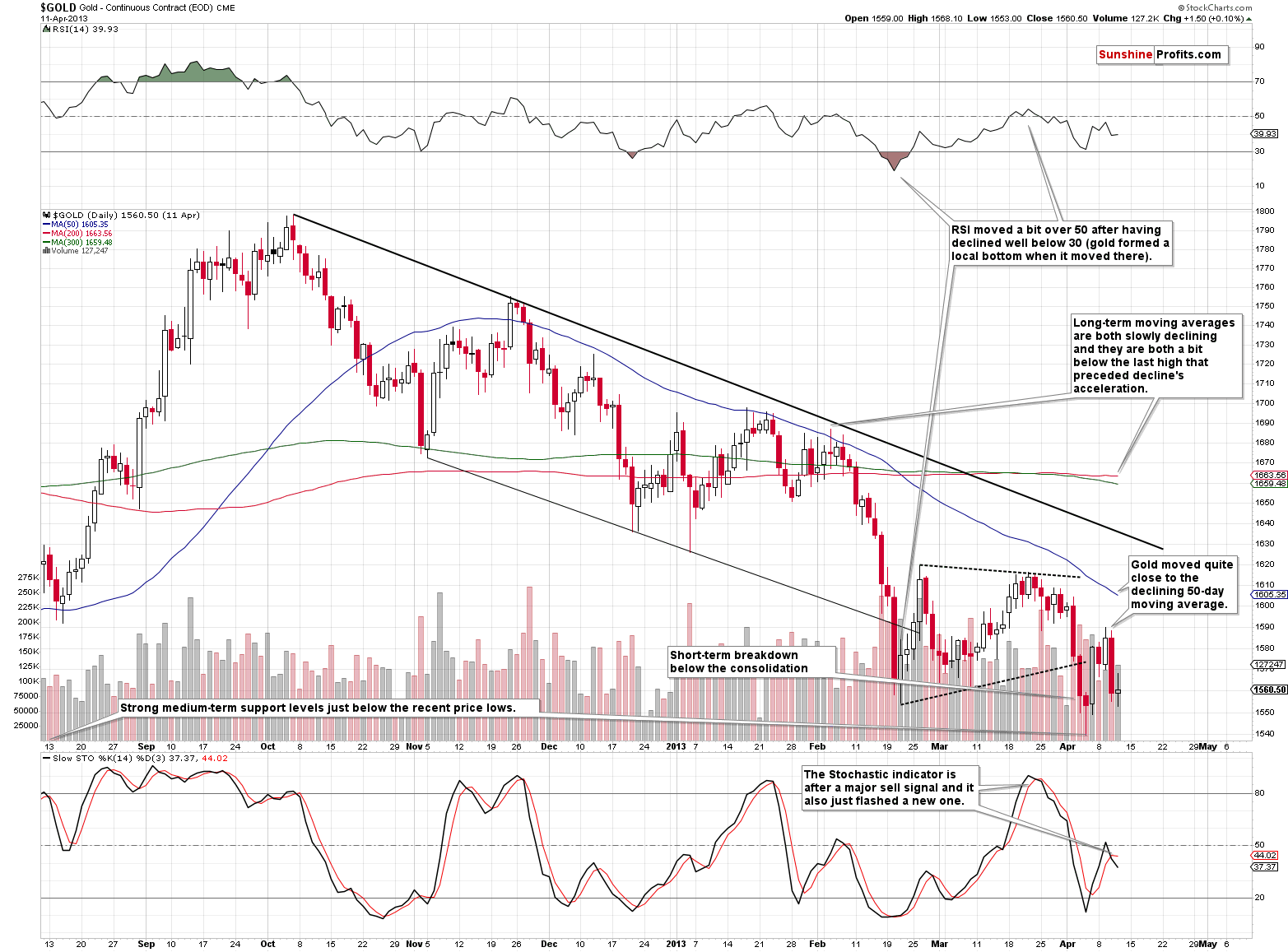
Back in 2013, gold broke below the lower dashed line, then moved back higher and then declined in a decisive manner, and it all took a bit more than a month.

Right now, gold broke below the lower dashed line (early September), then moved back higher and then (yesterday) declined in a decisive manner. It all took a bit more than a month.
If the analogy continues, gold is likely to decline in a very visible way shortly, as that’s what happened in 2013. In fact, back then gold declined more than $200 in just two trading days, so the implications are very bearish.
The other critical info from the analysis is that the next major turning point for gold that’s based on the vertex of the support-and-resistance triangles is just 2 weeks away.
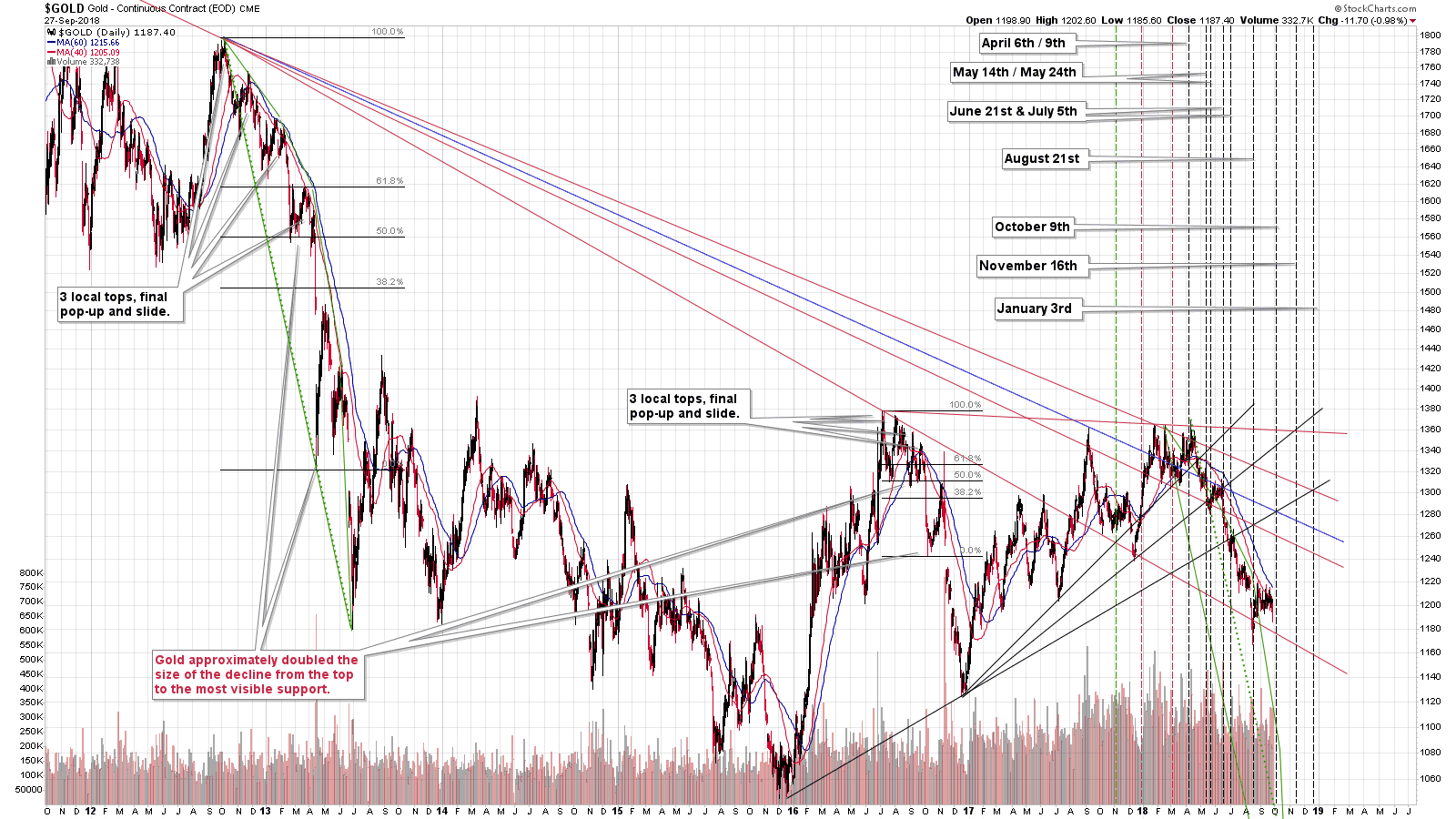
We recently saw the confirmation of the usefulness of this technique in case of silver and mining stocks, so the implications of the upcoming reversal are very much up-to-date. The reversal date is October the 9th, but since reversals may work on a near-to basis, the next major one – which is likely to be a bottom – may take place even sooner. This means that one should definitely pay attention to the precious metals market next week, as a lot is likely to happen.
Having said that, let’s move to the above-mentioned background info. By background info, we mean confirmations to some of the things that we covered previously.
Background Confirmations from Platinum, Silver, and Mining Stocks
Let’s start with platinum.
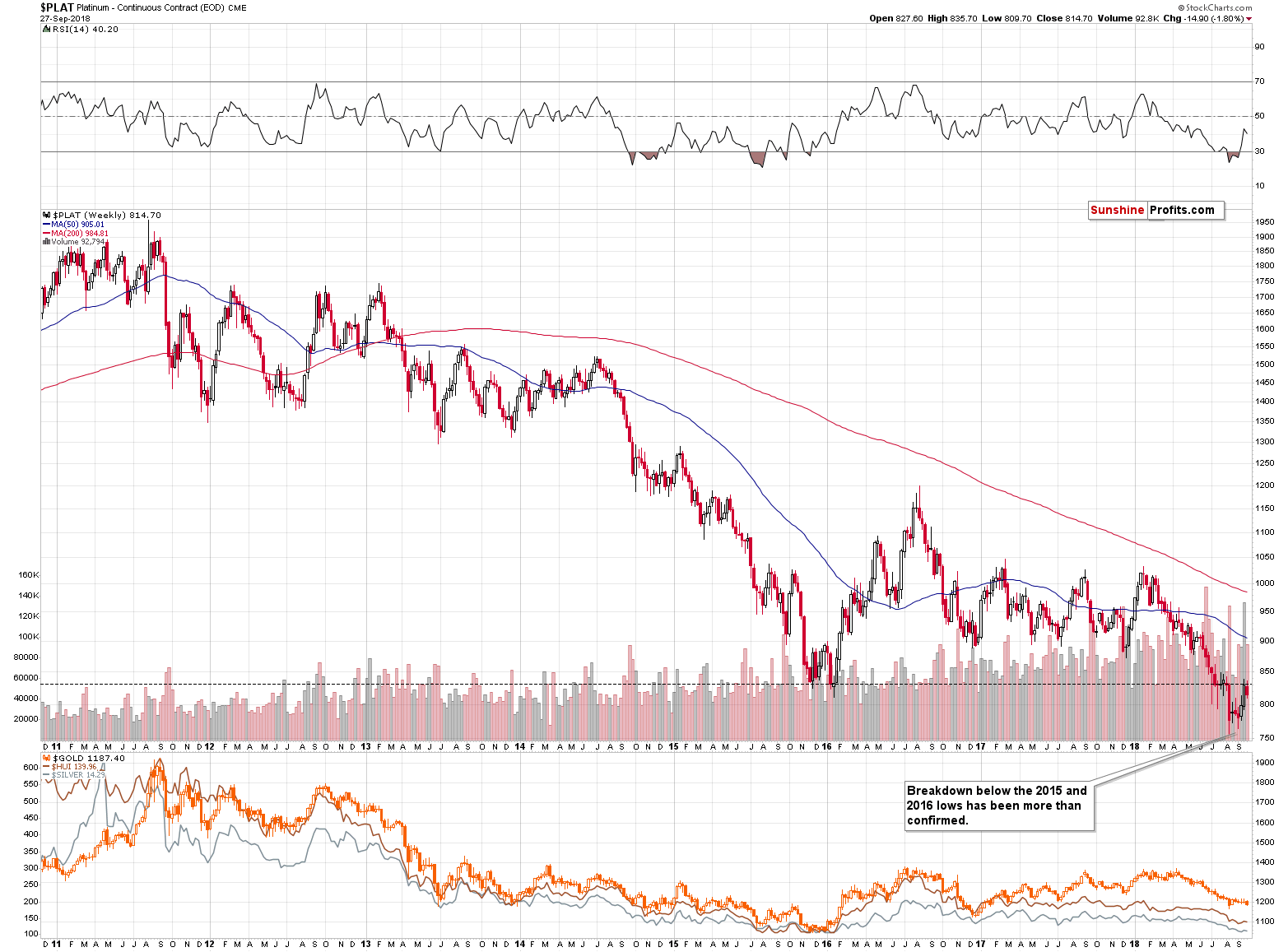
In Monday’s analysis, we wrote the following:
Platinum closed the week at $829.60, which means that there was no invalidation of the previous breakdown. This means that at the same time:
- There was nothing really bullish about last weeks upswing.
- The upside is very limited as very strong resistance is just above Friday’s closing price.
The above is a very bearish combination.
Platinum has moved $15 lower so far this week, confirming the bearish implications. The most recent upswing seems to have been nothing more than just a verification of the previous breakdown. The week is not over yet, but unless platinum rallies strongly today, we’ll have another weekly confirmation of the above. The outlook for the platinum market and for the rest of the precious metals sector remains bearish.
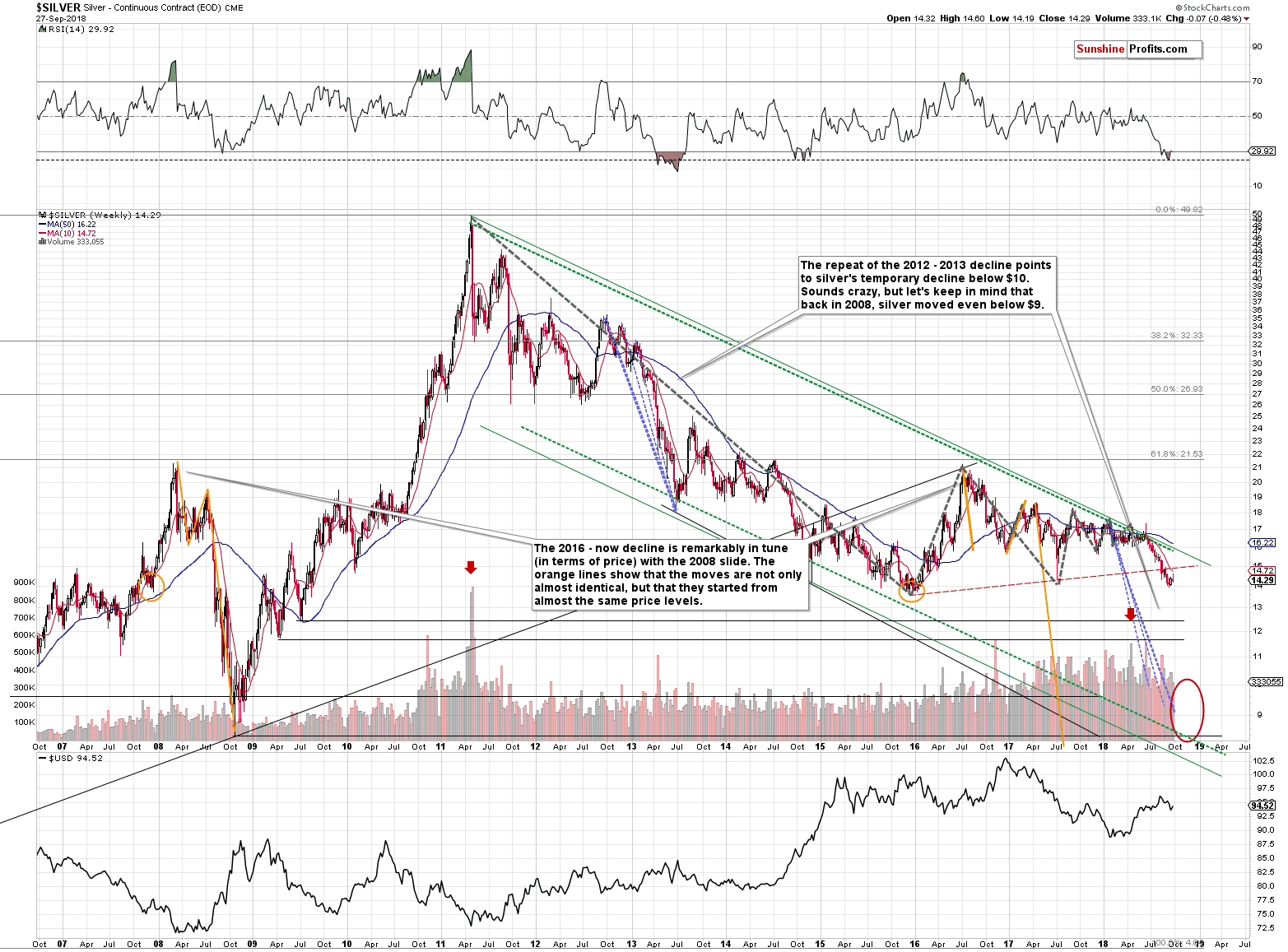
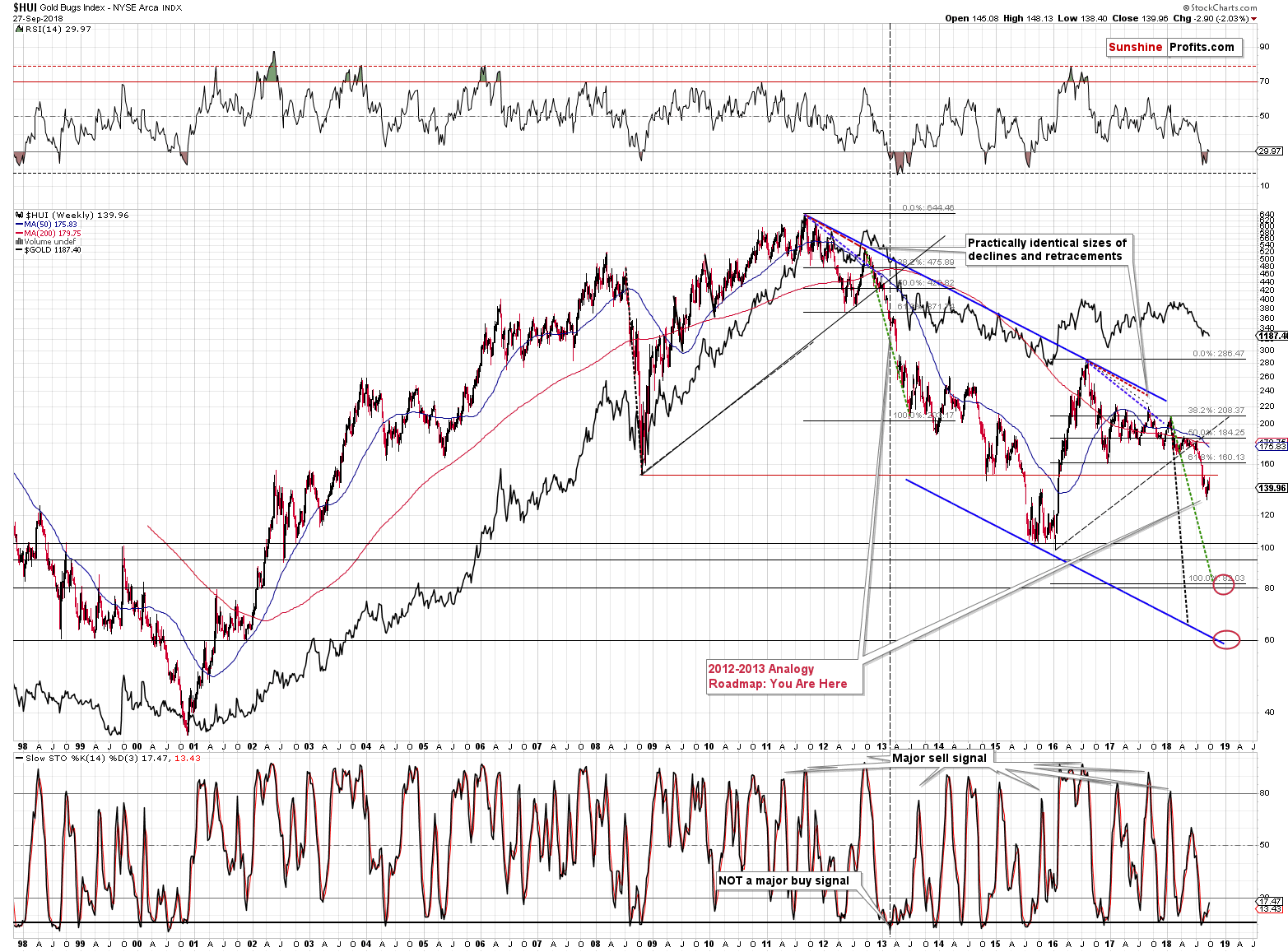
Speaking of weekly price changes, what we’ve seen so far this week in silver and the HUI Index is just a big weekly reversal candlestick. Unless we see a sizable rally today, the implications for the following days and weeks will be very bearish.
At the moment of writing these words, gold and silver are not rallying strongly, so the odds are that we are going to see the above-mentioned bearish confirmations shortly.
Forex Implications
As far as the currency markets are concerned, last Friday, we wrote the following:
In short, the USDX moved to one of the rising support lines and at the same time it seems to have completed a zigzag correction. Interestingly, the rally that started in the first quarter of this year is symmetrical to the decline that preceded it. The April – May 2018 rally is similar to the December 2017 decline and the same goes for the rest of the move. The October – December 2017 top took form of a head-and-shoulders pattern and it seems that we have also seen a similar pattern in the USDX (July high being the left shoulder, and the early September top being the right shoulder). And, just like the September – October 2017 zigzag started the previous correction, the August – September 2018 zigzag might be ending the current one. The implications of this specific symmetry are bullish for the USDX and bearish for the precious metals sector.
But, even if the gold-USDX link weakened and its predictive strength is currently not as what it used to be, then we are still likely to get meaningful signals from the analysis of the Japanese yen, as the situation in the latter should be relatively unaffected by the UK-EU dilemma.

The yen simply points to lower values of both: the currency and the price of gold. Last week, we saw a major breakdown below the rising long-term support line. Since the yen declined also this week, the move is getting confirmed and the implications are getting increasingly more bearish.
In short, the above remains up-to-date. The USD Index continues its mirror pattern, which may eventually become an inverse head-and-shoulders pattern with very bullish implications and target of about 105 – 107. Meanwhile, the situation in the Japanese yen is quite straightforward. The Japanese yen is after a major breakdown, and while there may be some short-term corrections (in today’s Forex Trading Alert, we take partial profits from the position in the yen), the general trend remains unchanged. And the same goes for the implications for the precious metals market, which remain bearish.
Note on Incomplete Patterns
On a side note, we put “may eventually” in bold, as we noticed that even though we described how incorrect it is to view incomplete head-and-shoulders pattern, we saw it being done (with regard to gold) in one of the analyses that we wrote recently. Over a year ago, we wrote the following about the possible inverse H&S pattern in gold:
(…) Having said that, let’s move on to the key issue.
Even if the above confirmations did indeed confirm the pattern instead of invalidating it, there would be no bullish implications for gold at this time. Why? Because there is no pattern to speak of – yet. In the case of the neck level based on the daily closing prices and the recent closes, there was no breakout above the neck level of the pattern.
The whole point of a pattern is that it has implications once it is completed and that’s not the case with the discussed reverse head and shoulders pattern in gold. If there were any meaningful implications of a given pattern before it was completed, then the part of this pattern would be a different pattern that would have a different name. For instance, a head-and-1.5-shoulders pattern or something more fancy. Either way, since the incomplete reverse H&S pattern is not known to be any pattern by itself, it does not have any implications – at least at this time.
We even provided the above publicly, hoping that it would prevent other analysts from making the significant logical error of viewing incomplete patterns as complete ones. But it didn’t.
Interestingly, that’s a proof of why the technical patterns can work over and over again, even though they are generally known. People still fall for the same psychological and emotional traps, because it’s so difficult to control and overcome them. The vast majority of people can’t, which is why most individual investors tend to lose money when trading. Since we see that even some professional analysts can’t sometimes overcome the biases, then what chance do individual investors (especially beginning investors) really have in the battle against the market? Unless they dedicate their time to properly preparing themselves or have someone trusted to take care of them, their chances of making money over time may be quite small.
Important Analyses
Before summarizing, we would like to emphasize that we have recently posted several analyses that are very important and that one should keep in mind, especially in the next several weeks. If you haven’t had the chance of reading them previously, we encourage you to do so today:
- Dear Gold Investor - Letters from 2013 - Analogy to 2013, which should make it easier to trade the upcoming sizable upswing (if enough factors point to it, that is) and to enter the market close to the final bottom.
- Gold to Soar Above $6,000 - discussion of gold’s long-term upside target of $6,000.
- Preparing for THE Bottom in Gold: Part 6 – What to Buy - extremely important analysis of the portfolio structure for the next huge, multi-year rally in the precious metals.
- Preparing for THE Bottom in Gold: Part 7 – Buy-and-hold on Steroids - description of a strategy dedicated to significantly boosting one’s long-term investment returns while staying invested in the PM sector.
- Gold’s Downside Target, Upcoming Rebound, and Miners’ Buy Plan - details regarding the shape of the following price moves, a buying plan for mining stocks, and a brief discussion of the final price targets for the current decline.
- Gold: What Happened vs. What Changed - discussion of the latest extreme readings from gold’s CoT report
- Key Factors for Gold & Silver Investors - discussion of key, long-term factors that support the bearish outlook for PMs. We are often asked what makes us so bearish – this article is a reply to this question.
- The Upcoming Silver Surprise - two sets of price targets for gold, silver and mining stocks: the initial and the final one.
- Precious Metals Sector: It’s 2013 All Over Again - comparison between 2013 and 2018 throughout the precious metals sector, the general stock market and the USD Index. Multiple similarities point to the repeat of a 2013-style volatile decline in the PMs.
Summary
Summing up, it seems that the next big downswing in the precious metals sector is already underway. We saw the repeat of mining stocks’ bearish shooting star candlestick, we also saw a very short-term outperformance of silver, and – yesterday – we saw move higher in the USDX, to which gold responded by. Not to mention the multiple signs that have been pointing to the lower PM prices in the following weeks for a long time. All in all, it seems that the huge profits on our short positions will soon become enormous.
As always, we’ll keep you – our subscribers – informed.
To summarize:
Trading capital (supplementary part of the portfolio; our opinion): Full short positions (250% of the full position) in gold, silver and mining stocks are justified from the risk/reward perspective with the following stop-loss orders and exit profit-take price levels:
- Gold: profit-take exit price: $1,062; stop-loss: $1,226; initial target price for the DGLD ETN: $82.96; stop-loss for the DGLD ETN $53.67
- Silver: profit-take exit price: $12.72; stop-loss: $15.16; initial target price for the DSLV ETN: $46.97; stop-loss for the DSLV ETN $31.37
- Mining stocks (price levels for the GDX ETF): profit-take exit price: $13.12; stop-loss: $19.61; initial target price for the DUST ETF: $80.97; stop-loss for the DUST ETF $33.37
Note: the above is a specific preparation for a possible sudden price drop, it does not reflect the most likely outcome. You will find a more detailed explanation in our August 1 Alert. In case one wants to bet on junior mining stocks’ prices (we do not suggest doing so – we think senior mining stocks are more predictable in the case of short-term trades – if one wants to do it anyway, we provide the details), here are the stop-loss details and target prices:
- GDXJ ETF: profit-take exit price: $17.52; stop-loss: $29.43
- JDST ETF: initial target price: $154.97 stop-loss: $64.88
Long-term capital (core part of the portfolio; our opinion): No positions (in other words: cash)
Insurance capital (core part of the portfolio; our opinion): Full position
Important Details for New Subscribers
Whether you already subscribed or not, we encourage you to find out how to make the most of our alerts and read our replies to the most common alert-and-gold-trading-related-questions.
Please note that the in the trading section we describe the situation for the day that the alert is posted. In other words, it we are writing about a speculative position, it means that it is up-to-date on the day it was posted. We are also featuring the initial target prices, so that you can decide whether keeping a position on a given day is something that is in tune with your approach (some moves are too small for medium-term traders and some might appear too big for day-traders).
Plus, you might want to read why our stop-loss orders are usually relatively far from the current price.
Please note that a full position doesn’t mean using all of the capital for a given trade. You will find details on our thoughts on gold portfolio structuring in the Key Insights section on our website.
As a reminder – “initial target price” means exactly that – an “initial” one, it’s not a price level at which we suggest closing positions. If this becomes the case (like it did in the previous trade) we will refer to these levels as levels of exit orders (exactly as we’ve done previously). Stop-loss levels, however, are naturally not “initial”, but something that, in our opinion, might be entered as an order.
Since it is impossible to synchronize target prices and stop-loss levels for all the ETFs and ETNs with the main markets that we provide these levels for (gold, silver and mining stocks – the GDX ETF), the stop-loss levels and target prices for other ETNs and ETF (among other: UGLD, DGLD, USLV, DSLV, NUGT, DUST, JNUG, JDST) are provided as supplementary, and not as “final”. This means that if a stop-loss or a target level is reached for any of the “additional instruments” (DGLD for instance), but not for the “main instrument” (gold in this case), we will view positions in both gold and DGLD as still open and the stop-loss for DGLD would have to be moved lower. On the other hand, if gold moves to a stop-loss level but DGLD doesn’t, then we will view both positions (in gold and DGLD) as closed. In other words, since it’s not possible to be 100% certain that each related instrument moves to a given level when the underlying instrument does, we can’t provide levels that would be binding. The levels that we do provide are our best estimate of the levels that will correspond to the levels in the underlying assets, but it will be the underlying assets that one will need to focus on regarding the signs pointing to closing a given position or keeping it open. We might adjust the levels in the “additional instruments” without adjusting the levels in the “main instruments”, which will simply mean that we have improved our estimation of these levels, not that we changed our outlook on the markets. We are already working on a tool that would update these levels on a daily basis for the most popular ETFs, ETNs and individual mining stocks.
Our preferred ways to invest in and to trade gold along with the reasoning can be found in the how to buy gold section. Additionally, our preferred ETFs and ETNs can be found in our Gold & Silver ETF Ranking.
As a reminder, Gold & Silver Trading Alerts are posted before or on each trading day (we usually post them before the opening bell, but we don't promise doing that each day). If there's anything urgent, we will send you an additional small alert before posting the main one.
=====
Latest Free Trading Alerts:
It should be clear that the Fed’s tightening is bearish for gold, shouldn’t it? Our today’s about the history of the Fed’s tightening and its impact on the macroeconomic variables and the gold prices undermines that popular belief. We invite you to read it and draw precious metals investment conclusions from it.
Fed Tightening Cycles: Broader View and Implications for Gold
=====
Thank you.
Sincerely,
Przemyslaw Radomski, CFA
Founder, Editor-in-chief, Gold & Silver Fund Manager
Gold & Silver Trading Alerts
Forex Trading Alerts
Oil Investment Updates
Oil Trading Alerts




